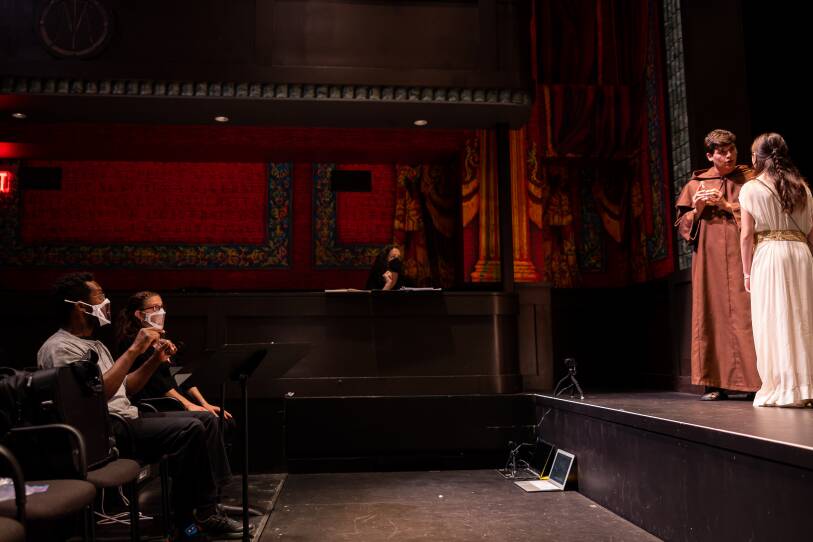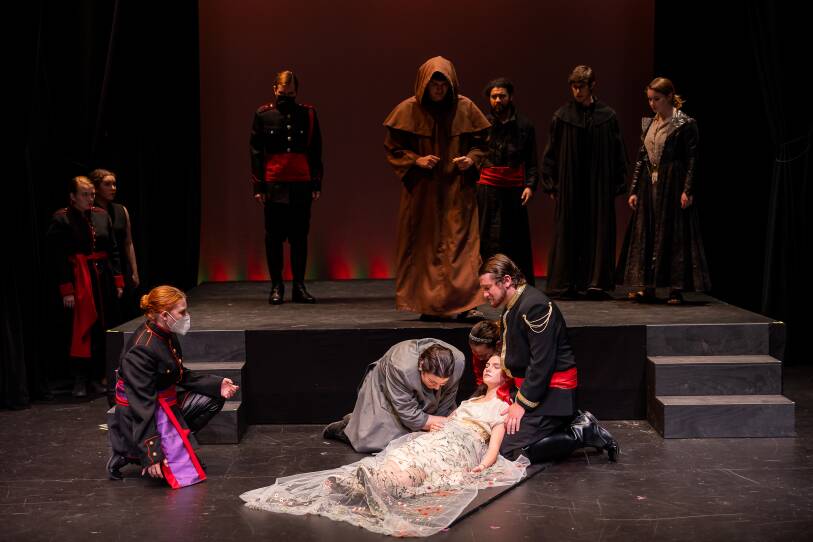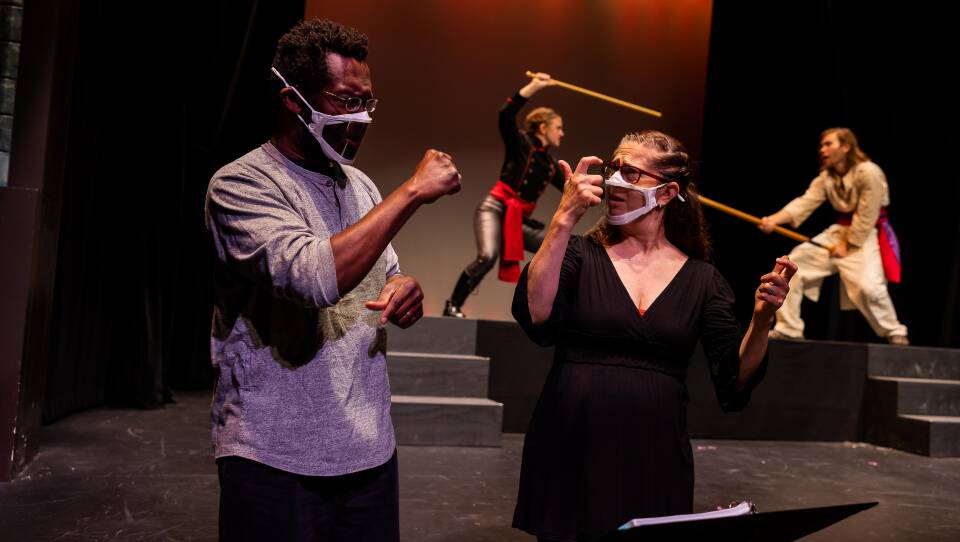The words and works of William Shakespeare were not of particular interest to a young Rachel Berman-Kobylarz. She wasn't unfamiliar with the Bard — she did take English literature classes in high school where Shakespeare played a major part — but in her words, she described her attitude as unenthused.
"I perceived Shakespeare as elitist, only for those who were into Shakespeare and can understand and speak and hear the King's English," she said through an interpreter. "It was for them, not me."
Attitudes change, though. Today, Berman-Kobylarz, who is Deaf, is fluent in Shakespeare. She’s a full-time American Sign Language Teacher at Northeastern University and a director of Artistic Sign Language (DASL), a job that requires one to consider dramaturgy, research of other sign languages and how the act of interpretation is integrated into the production itself. She's also a co-facilitator for HandShakes.
HandShakes, an ASL-English Shakespeare interpretation program for Deaf and hearing interpreters, is an initiative of The Commonwealth Shakespeare Company , which is a fixture of Boston summers through its annual free productions on Boston Common. When I met Berman-Kobylarz at Suffolk University, HandShakes was in session doing table work for a production of "Romeo and Juliet" that would kick off the Commonwealth Shakespeare Company's Apprentice Showcase.
HandShakes' staff has been involved in the production of “Romeo and Juliet” from the start. Having artistic decision makers around from conception to execution seems like a given, but in Berman-Kobylarz's experience that has been far from the case. Before moving to Boston, she worked in Colorado, where she noticed some problems with how productions employed her expertise.
Too often, interpreters — not Deaf people — would take the lead on production design and selecting other peer interpreters. It wouldn’t be until the end of the process that they'd seek out Berman-Kobylarz's artistic input, but by that point it would be too late. It was, as she tells it, a lazy effort to put "deaf eyes" on the production. "There was no involvement of the Deaf person or Deaf artist to be involved in the translation process, the table reading, the convening, the rehearsal process until the 11th hour," she said.
The collaborative atmosphere in Boston is an improvement, and Berman-Kobylarz described the experience as a new professional journey. "In this area, the director of artistic sign languages was hired first," she explained. "It is the next level of involvement and engagement, to not wait till the 11th hour to bring in someone like myself, but allowing me, as a director of artistic sign language... to select, hire and cast the sign language interpreters."

Technically, there are a lot of creative choices for the HandShakes team when they put on an accessible performance. Take lighting, for instance. If it's too dim, then audience members can't see what's being signed. There's the fact that there are a finite number of interpreters, too — decisions must be made so audiences can figure out how to distinguish which signs correspond to which character.
There is visibility to consider, too. "Where Deaf people are sitting is really important," said Director of Artistic Sign Language Kristin Johnson. The Deaf audience needs to be able to see the whole stage from where they're sitting, instead of switching focus from character to interpreter, like "watching a tennis ball lobbing back and forth." Then there's the matter of translation. Interpreters sign the voiced language of the actors on stage, but these translations are not word-for-word.
Because ASL is a completely different and distinct language from spoken English, a good translation requires a good deal of creativity and understanding of Deaf culture and language. Jill Bradbury, performing arts chair of the Rochester Institute of Technology’s National Technical Institute for the Deaf, says Shakespeare is an excellent tool for enhancing a person's interpretation skills.
"His [Shakespeare's] creativity is unparalleled for me," she explained. "I think that what Shakespeare gives me is... the ability to play with language, creativity and translation. This is very much the aesthetics of paring down language."
For an example, Bradbury, who is also Deaf, walked me through the opening of Hamlet’s "To be, or not to be" soliloquy :
"To be, or not to be, that is the question:
Whether 'tis nobler in the mind to suffer
The slings and arrows of outrageous fortune,
Or to take Arms against a Sea of troubles,
And by opposing end them: to die, to sleep
No more; and by a sleep, to say we end
The heart-ache, and the thousand natural shocks
That Flesh is heir to?"
Among the dense figurative language of the monologue, Bradbury zoomed in on the matter of slings and arrows. "How do you express that in sign language?" she pondered. "If you literally translated this, it wouldn't have context; it would be really difficult to understand." She pointed out some fundamental differences between English and ASL. With the former, she explained, non-personalized constructs are a feature of the language. Bradbury emphasized that the idea of the individual suffering the figurative slings and arrows is sufficient expression enough, despite there being no actual person mentioned. Implication is everything. But ASL operates differently.
"I think that what Shakespeare gives me is... the ability to play with language, creativity and translation. This is very much the aesthetics of paring down language."-Jill Bradbury, performing arts chair, Rochester Institute of Technology’s National Technical Institute for the Deaf
"Sign language is very directional," said Bradbury. "When an action is happening, it's simply happening to somebody. So to try and express this abstract idea, you have to sort of put the person there." The result? An ASL translation that might be signed something along the lines of "life's arrows hit me."
Christopher Robinson is Commonwealth Shakespeare Company’s access advocate and a program director and a lead facilitator for HandShakes. For him, this work isn't just about translating the text, it’s about the practice of interpreting it. And this isn’t intrinsically unique to ASL — any language an interpreter is working with in this dramatic context will come with its own set of challenges and puzzles.
He said that the context in which these plays were written then and performed now is a major component of the work they must recognize. The nuances of Shakespeare’s words must be considered. "One word written in the 17th-century with the same exact spelling means something completely different in our contemporary context," he said.
As another example, Robinson singled out a passage from “Romeo and Juliet:”
"…I will be deaf to pleading and excuses;
Nor tears nor prayers shall purchase out abuses:
Therefore use none: let Romeo hence in haste,
Else, when he's found, that hour is his last."

In the context of working with Deaf people, Robinson singles this out as a particularly compelling line. “Here’s the term ‘deaf’,” he said. “In a world where people are trying to be ‘woke’, sometimes people will avoid using the word 'deaf' or 'disabled' because people believe those words [are] derogatory or ableist, when the majority of Deaf people, will say 'I am Deaf, I am proud of being deaf, and I don’t want any other euphemistic terms applied to me to emphasize my humanity.'”
It’s exceptionally powerful, then, that the Prince — a character in power — leans on deafness as an indicator that justice will be delivered. “That’s powerful,” said Robinson. “That’s a virtue being shared by the people in the room being found in the text.”
In this way, HandShakes is part of the larger tradition of theater work. Shakespeare’s plays have been translated and interpreted into a number of languages. That this work is being done with ASL should not be considered unique, but rather necessary as a means to include the whole of linguistic expression.
But as HandShakes relates to Deaf people specifically, Berman-Kobylarz sees it as a space to explore a dimension of language arts from which she has previously felt excluded. "This program is my first time, actually, to really unpack Shakespeare in a safe place for myself," she noted. "It was kind of an intimidating and daunting task — Shakespeare, the William Shakespeare. So we created a brave space to really explore this work. And so that's what I find is very valuable. And we're still building on it, discovering additional values to come."








